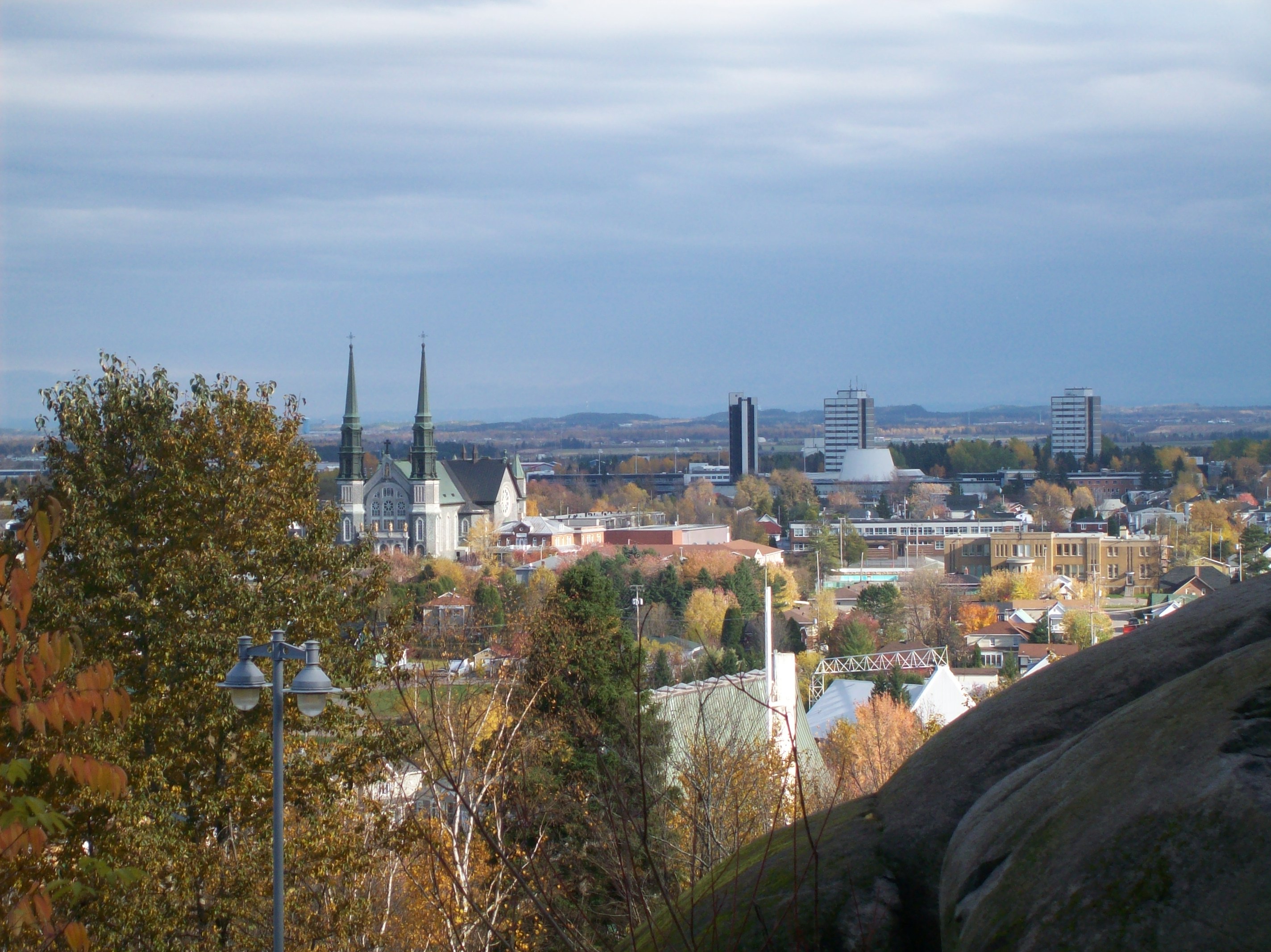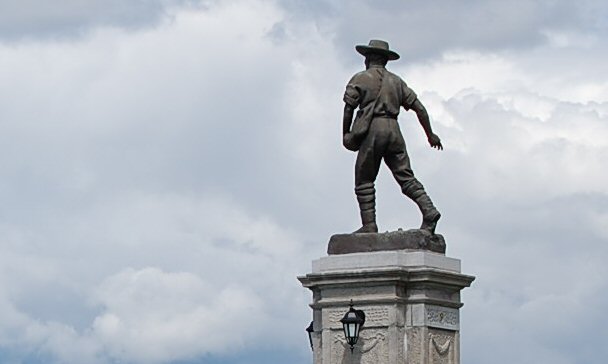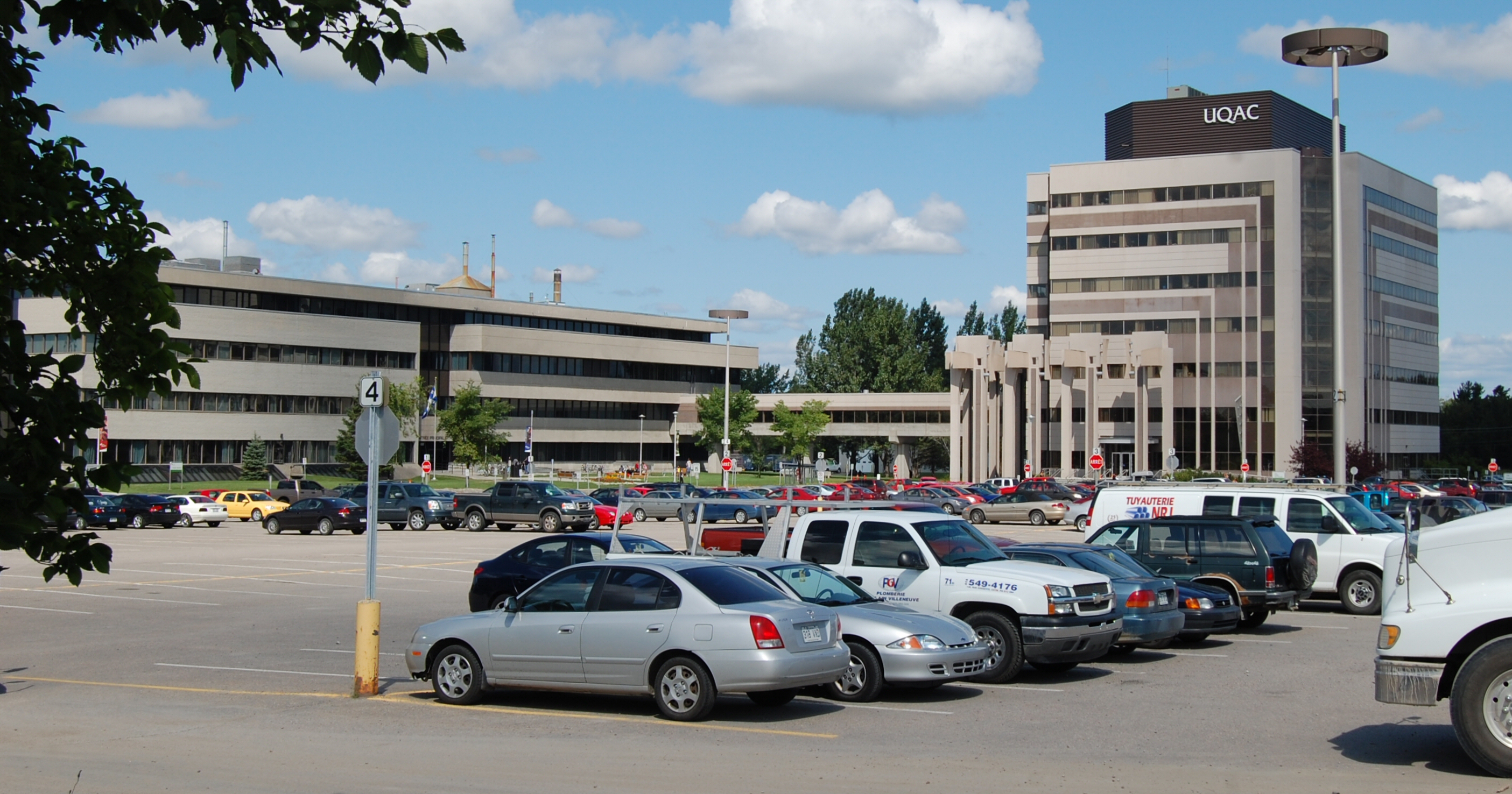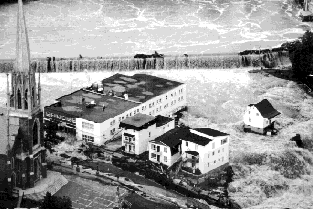|
Chicoutimi
Chicoutimi () is the most populous borough (arrondissement) of the city of Saguenay in Quebec, Canada. It is situated at the confluence of the Saguenay and Chicoutimi rivers. During the 20th century, it became the main administrative and commercial centre of the Saguenay–Lac-Saint-Jean region. In 2002 it merged into the new city of Saguenay and forms the heart of the 5th-largest urban area of the province of Quebec. At the 2021 census, its population was 69,004. History What was ultimately to become the centre of the borough of Chicoutimi was first settled by French colonists in 1676 as a trading post in the fur trade. At that time, the Saguenay and the Chicoutimi rivers had been used as waterways by the Montagnais tribes for centuries. The name ''Chicoutimi'' means ''the end of the deep water'' in the Innu language. After the British seized Lower Canada, the Chicoutimi trading post continued to operate only until 1782, as the fur trade had moved further west of the ... [...More Info...] [...Related Items...] OR: [Wikipedia] [Google] [Baidu] |
Chicoutimi River
The Chicoutimi River is a watercourse of eastern Quebec, Canada. A tributary of the Saguenay River, which it meets in the city of Saguenay, it is the main outlet of Kenogami Lake, which rises from a watershed of in the Laurentides Wildlife Reserve. Entirely located in the Chicoutimi borough of Saguenay, it is the most urbanized and dammed river in Saguenay–Lac-Saint-Jean. Used by the Montagnais of the Saguenay River before the arrival of Europeans, it was at that time the first portage from the main access road to Lac Saint-Jean. In the 20th century, it was developed from its source to its mouth for hydropower purposes. In addition to being the source of drinking water for the Chicoutimi and Jonquière boroughs, this river has six dams (including 2 hydroelectric power plants in operation). During the Saguenay flood in 1996, its surge caused significant damage to Laterrière and Chicoutimi. Geography Course and hydrogeology The Chicoutimi River rises at Portage-des- ... [...More Info...] [...Related Items...] OR: [Wikipedia] [Google] [Baidu] |
Saguenay, Quebec
Saguenay ( , , ) is a city in the Saguenay–Lac-Saint-Jean region of Quebec, Canada, on the Saguenay River, about north of Quebec City by overland route. It is about upriver and northwest of Tadoussac, located at the confluence with the St. Lawrence River. It was formed in 2002 by merging the cities of Chicoutimi and Jonquière and the town of La Baie, Quebec, La Baie. Chicoutimi was founded by French colonists in 1676. The city of Saguenay constitutes a territory equivalent to a regional county municipality (TE); its geographical code is 941. Together with the regional county municipality of Le Fjord-du-Saguenay Regional County Municipality, Le Fjord-du-Saguenay, it forms the Census geographic units of Canada, census division (CD) of Le Saguenay-et-son-Fjord (94). The mayor of Saguenay since 2021 is Julie Dufour. Prior to its use as the name of the city, the term "the Saguenay" or (less commonly) "Saguenay Valley" had already been used for the whole Saguenay River region (se ... [...More Info...] [...Related Items...] OR: [Wikipedia] [Google] [Baidu] |
Chicoutimi, Quebec (1893)
Chicoutimi () is the most populous borough ( arrondissement) of the city of Saguenay in Quebec, Canada. It is situated at the confluence of the Saguenay and Chicoutimi rivers. During the 20th century, it became the main administrative and commercial centre of the Saguenay–Lac-Saint-Jean region. In 2002 it merged into the new city of Saguenay and forms the heart of the 5th-largest urban area of the province of Quebec. At the 2021 census, its population was 69,004. History What was ultimately to become the centre of the borough of Chicoutimi was first settled by French colonists in 1676 as a trading post in the fur trade. At that time, the Saguenay and the Chicoutimi rivers had been used as waterways by the Montagnais tribes for centuries. The name ''Chicoutimi'' means ''the end of the deep water'' in the Innu language. After the British seized Lower Canada, the Chicoutimi trading post continued to operate only until 1782, as the fur trade had moved further west of th ... [...More Info...] [...Related Items...] OR: [Wikipedia] [Google] [Baidu] |
Chicoutimi - UQAC
Chicoutimi () is the most populous borough ( arrondissement) of the city of Saguenay in Quebec, Canada. It is situated at the confluence of the Saguenay and Chicoutimi rivers. During the 20th century, it became the main administrative and commercial centre of the Saguenay–Lac-Saint-Jean region. In 2002 it merged into the new city of Saguenay and forms the heart of the 5th-largest urban area of the province of Quebec. At the 2021 census, its population was 69,004. History What was ultimately to become the centre of the borough of Chicoutimi was first settled by French colonists in 1676 as a trading post in the fur trade. At that time, the Saguenay and the Chicoutimi rivers had been used as waterways by the Montagnais tribes for centuries. The name ''Chicoutimi'' means ''the end of the deep water'' in the Innu language. After the British seized Lower Canada, the Chicoutimi trading post continued to operate only until 1782, as the fur trade had moved further west of th ... [...More Info...] [...Related Items...] OR: [Wikipedia] [Google] [Baidu] |
La Baie, Quebec
La Baie (French pronunciation: / la bɛ/, Quebec French pronunciation: / la be/) is one of three boroughs in the city of Saguenay, Quebec, Canada. It was created during Quebec's municipal reorganization in 2002. From 1976 to 2001, it was known as the Town of La Baie, a municipality composed of the Grande-Baie, Bagotville and Port-Alfred sectors. It is located on the bank of the Ha! Ha! Bay (French: ''baie des Ha! Ha!'') at the mouths of the Ha! Ha! River (French: ''rivière Ha! Ha!'') and the Mars River (French: ''rivière à Mars''). La Baie was the first colony built in the Saguenay-Lac-St-Jean region. It was founded by the Société des Vingt et un who settled the area in 1838. The depth of the banks of the Ha! Ha! Bay's waterways facilitated the rapid development of the region's largest harbour facilities after the railways were built in 1910. The borough's main sources of socio-economic development have been the logging and the pulp and paper industries since the nin ... [...More Info...] [...Related Items...] OR: [Wikipedia] [Google] [Baidu] |
Chicoutimi Station
Chicoutimi station is a former Canadian National Railway Company railway station in the Chicoutimi borough of the city of Saguenay in Quebec's Saguenay–Lac-Saint-Jean Saguenay–Lac-Saint-Jean (, ) is a region in Quebec, Canada. It contains the Saguenay Fjord, the estuary of the Saguenay River, stretching through much of the region. It is also known as Sagamie in French, from the first part of "Saguenay" and th ... region. When the station was built, it was adjacent to Chicoutimi's port. All train service to Chicoutimi ended in 1988. On April 29, 1988, the Railway Transport Committee of the Canadian Transport Commission authorized CN to abandon its line between Ha Ha Bay Junction and Chicoutimi, and CN and VIA Rail to abandon passenger service between Jonquière and Chicoutimi. The building is still in use, following controversial renovations in 1995, but is no longer connected to the railway network. References Sources * * Railway stations in Saguenay–Lac-Sai ... [...More Info...] [...Related Items...] OR: [Wikipedia] [Google] [Baidu] |
Roman Catholic Diocese Of Chicoutimi
The Diocese of Chicoutimi ( la, Dioecesis Chicoutimiensis) is a Roman Catholic diocese in Quebec, centred on the borough of Chicoutimi in the city of Saguenay. It is part of the ecclesiastical province of Quebec. On 18 November 2017, Pope Francis appointed René Guay, a priest of Chicoutimi, as the new bishop.David M. Cheney, Catholic-Hierarchy.orgRene Guay retrieved: 2017-11-19. Bishops * Dominique Racine (1878-1888) * Louis Nazaire Bégin (1888-1892), appointed Coadjutor Archbishop of Québec; future Cardinal * Michel-Thomas Labrecque (1892-1927) * Charles-Antonelli Lamarche (1928-1940) * Georges-Arthur Melançon (1940-1961) * Marius Paré (1961-1979) * Jean-Guy Couture (1979-2004) * André Rivest (2004-2017) * René Guay (2017- ) Coadjutor bishop * Marius Paré (1960-1961) Auxiliary bishops * Marius Paré (1956-1960), appointed Coadjutor here * Roch Pedneault (1974-2002) Other priests of this diocese who became bishops * Bertrand Blanchet, appointed Bis ... [...More Info...] [...Related Items...] OR: [Wikipedia] [Google] [Baidu] |
Université Du Québec à Chicoutimi
The Université du Québec à Chicoutimi (UQAC) is a branch of the Université du Québec network founded in 1969 and based in the Chicoutimi borough of Saguenay, Quebec, Canada. UQAC has secondary study centres in La Malbaie, Saint-Félicien, Alma, and Sept-Îles. In 2017, 7500 students were registered and 209 professors worked for the university, making it the fourth largest of the ten Université du Québec branches, after Université du Québec à Montréal (UQAM), Université du Québec à Trois-Rivières (UQTR), and École de technologie supérieure (ETS). Academics It offers over forty undergraduate and graduate programs. The university is especially well known for its researchers in aluminium (with two research centres), forestry, icing (in French, givrage), geology and historical population studies. In 2005, UQAC opened programs for students from foreign countries in partnership with universities from Morocco, Lebanon, China, Senegal, Colombia, and Brazil. In 200 ... [...More Info...] [...Related Items...] OR: [Wikipedia] [Google] [Baidu] |
Saguenay River
__NOTOC__ The Saguenay River () is a major river of Quebec, Canada. It drains Lac Saint-Jean in the Laurentian Highlands, leaving at Alma and running east; the city of Saguenay is located on the river. It drains into the Saint Lawrence River. Tadoussac, founded as a French colonial trading post in 1600, is located on the northeast bank at this site. The river has a very high flow-rate and is bordered by steep cliffs associated with the Saguenay Graben. Tide waters flow in its fjord upriver as far as Chicoutimi (about 100 kilometres). Many Beluga whales breed in the cold waters at its mouth, making Tadoussac a popular site for whale watching and sea kayaking; Greenland sharks also frequent the depths of the river. The area of the confluence of the Saguenay and Saint Lawrence is protected by the Saguenay–St. Lawrence Marine Park, one of Canada's national parks. History The Saguenay River was used as an important trade route into the interior for the First Nations people of ... [...More Info...] [...Related Items...] OR: [Wikipedia] [Google] [Baidu] |
Saguenay Flood
The Saguenay flood (french: Déluge du Saguenay) was a series of flash floods on July 19 and 20, 1996 that hit the Saguenay–Lac-Saint-Jean region of Quebec, Canada. It was the biggest overland flood in 20th-century Canadian history. History Problems started after two weeks of constant rain, which severely engorged soils, rivers and reservoirs. The Saguenay region is a geological graben, which increased the effect of the sudden massive rains of July 19, 1996. In two days, rainfall accumulated that was "equivalent to the volume of water that tumbles over Niagara Falls in four weeks." Over of water flooded parts of Chicoutimi and La Baie, completely levelling an entire neighbourhood. More than 16,000 people were evacuated. The official death toll was ten, but other sources (notably ''Canadian Geographic'') cite ten. Estimates reach in damages, a cost made greater by the disaster's occurrence at the height of the tourist season. Post-flood enquiries discovered that the networ ... [...More Info...] [...Related Items...] OR: [Wikipedia] [Google] [Baidu] |
Boroughs Of Saguenay, Quebec
Saguenay, Quebec is divided into three boroughs (french: arrondissements). * Chicoutimi * Jonquière * La Baie These were former cities which ceased to exist on February 18, 2002, when they were amalgamated into the expanded city of Saguenay. The amalgamation involved the following cities and municipalities in addition to the above: * the Municipality of Lac-Kénogami (now part of Jonquière borough) * the City of Laterrière (now part of Chicoutimi borough) * the Municipality of Shipshaw (now part of Jonquière borough) * part of the Township of Tremblay (now part of Chicoutimi borough; the rest of it was annexed to Saint-Honoré, Quebec, Saint-Honoré) External links Map showing boroughs {dead link, date=November 2016 , bot=InternetArchiveBot , fix-attempted=yes Boroughs of Saguenay, Quebec, Lists of populated places in Quebec, Boroughs, List of Saguenay Quebec ... [...More Info...] [...Related Items...] OR: [Wikipedia] [Google] [Baidu] |
Laterrière, Quebec
Laterrière is a community in the Saguenay–Lac-Saint-Jean region of Quebec and a former municipality. It is part of the merged city of Saguenay, Quebec Saguenay ( , , ) is a city in the Saguenay–Lac-Saint-Jean region of Quebec, Canada, on the Saguenay River, about north of Quebec City by overland route. It is about upriver and northwest of Tadoussac, located at the confluence with the St. .... Laterrière was founded by Jean-Baptiste Honorat in 1846. References * * * * External links *Mémoires d'un village : Laterrière, Saguenay, 1900–1960. Livre disponible, en texte intégral, dans Les Classiques des sciences sociales, avec l'autorisation de l'auteur Neighbourhoods in Saguenay, Quebec Former municipalities in Quebec Former cities in Quebec {{Quebec-geo-stub ... [...More Info...] [...Related Items...] OR: [Wikipedia] [Google] [Baidu] |



.jpg)



